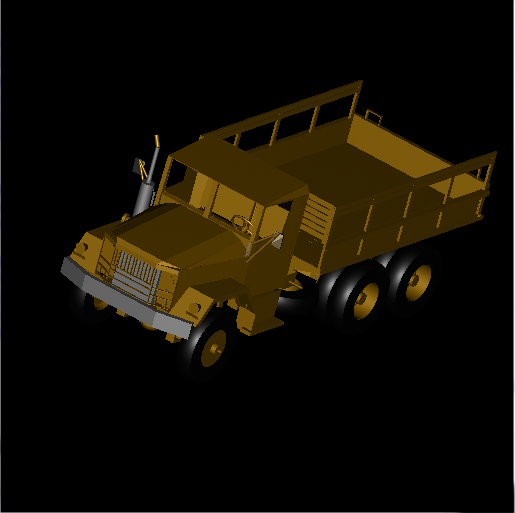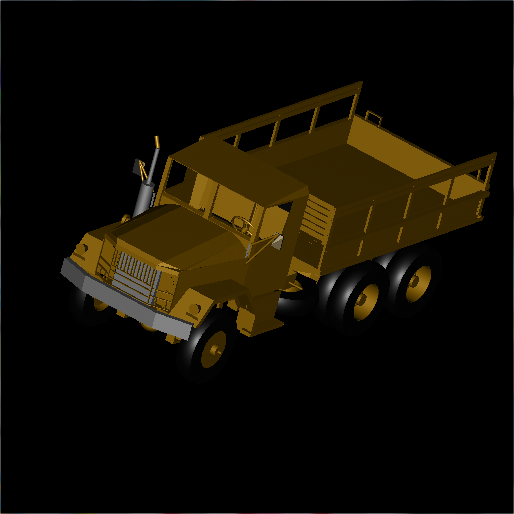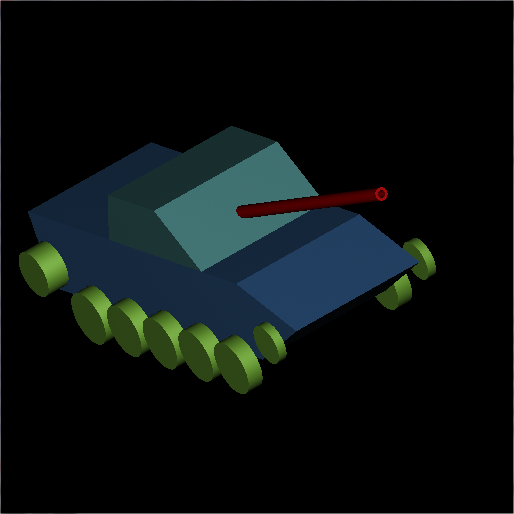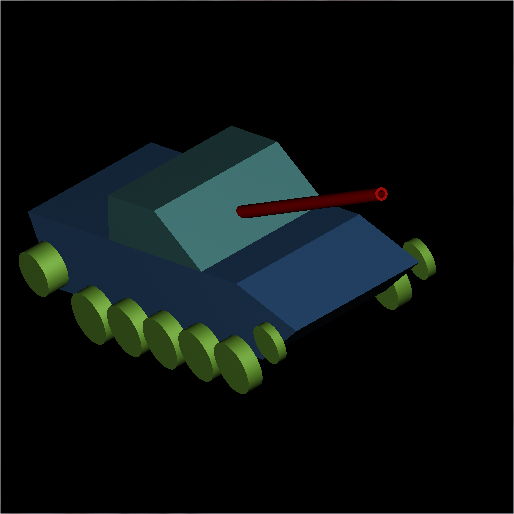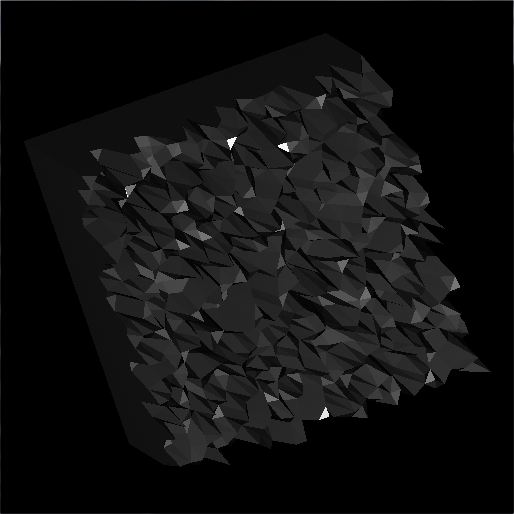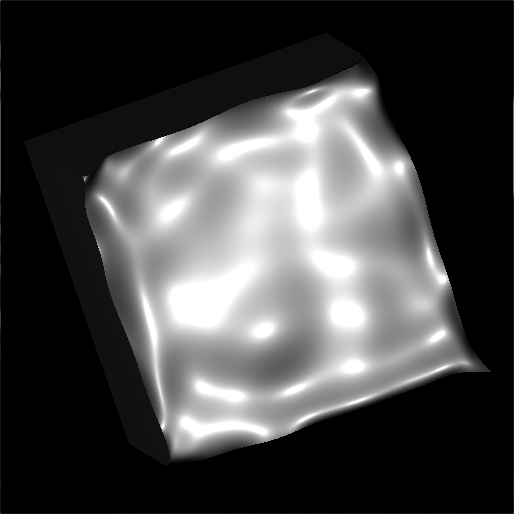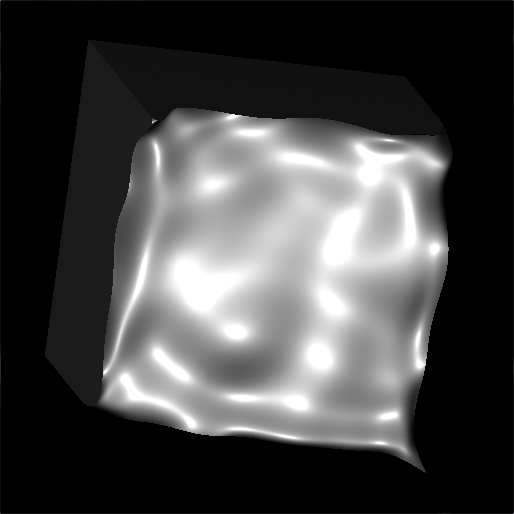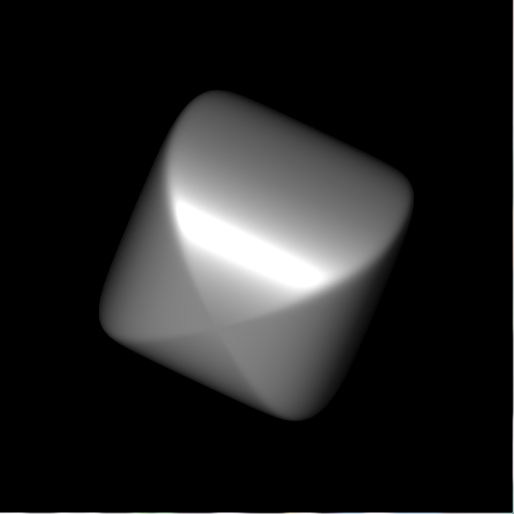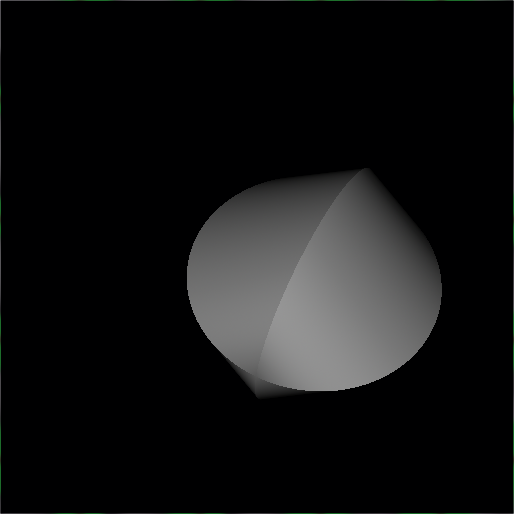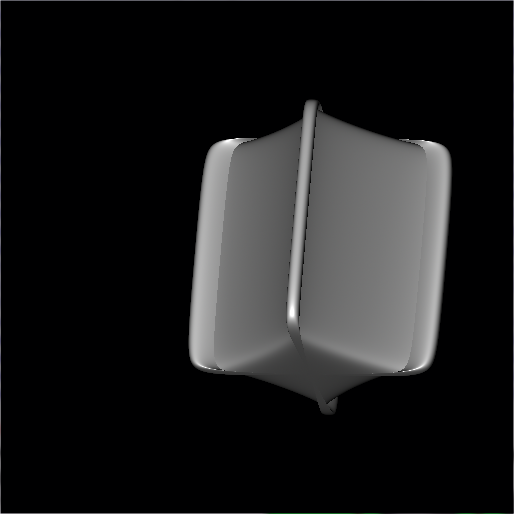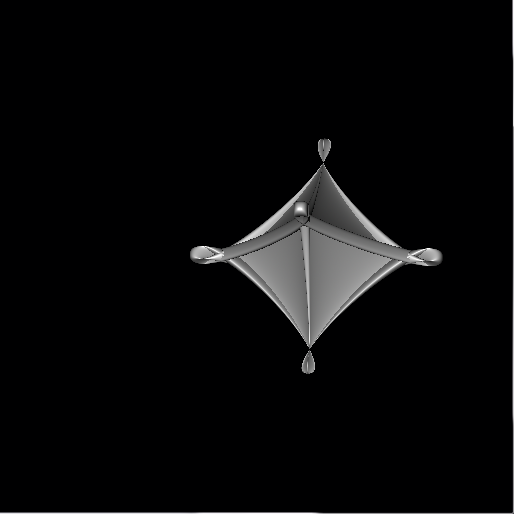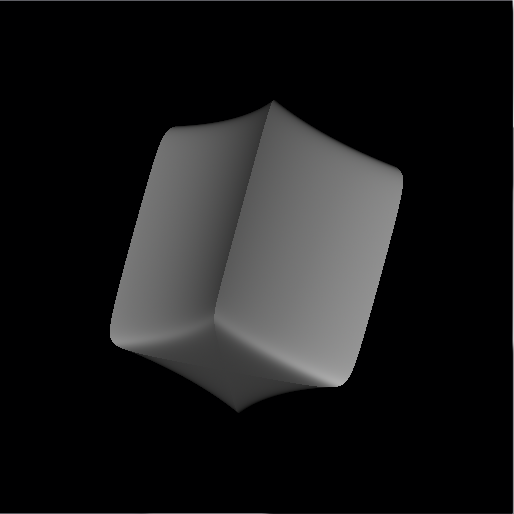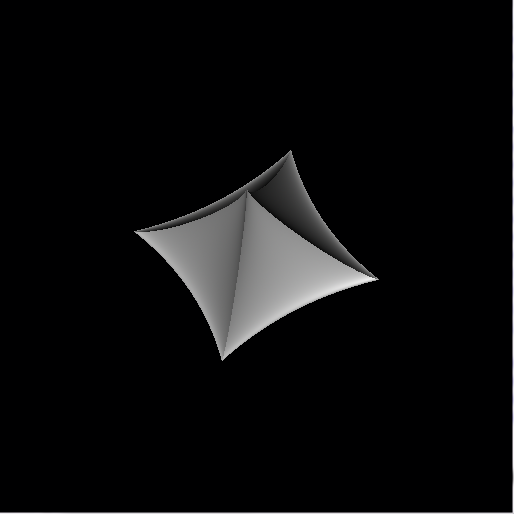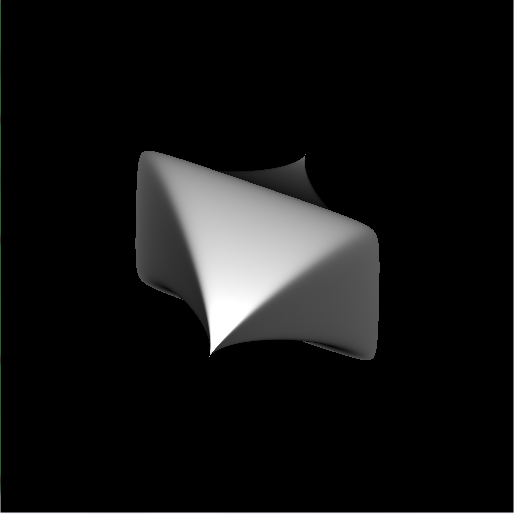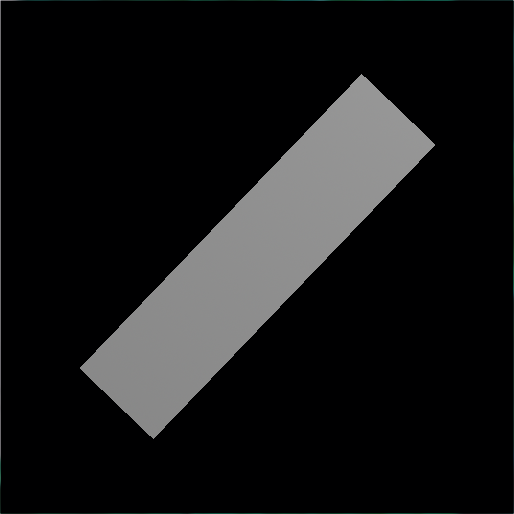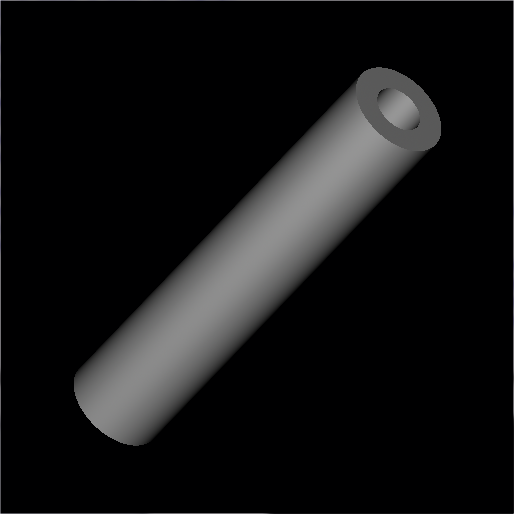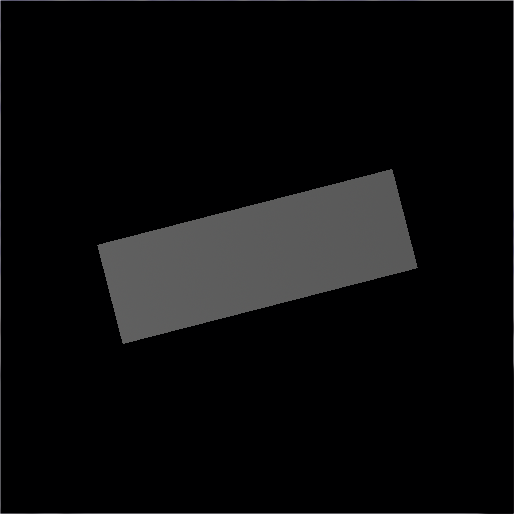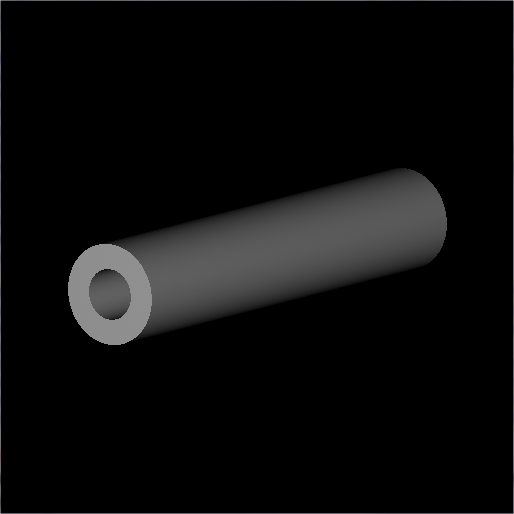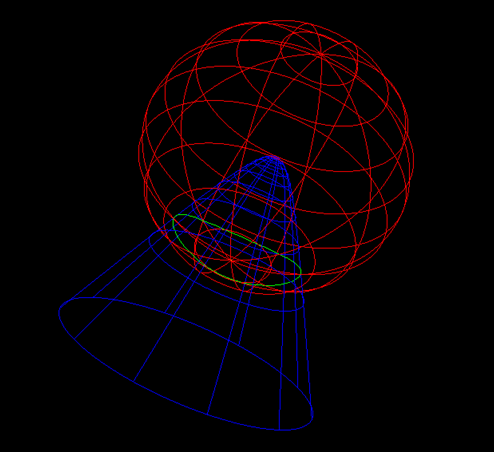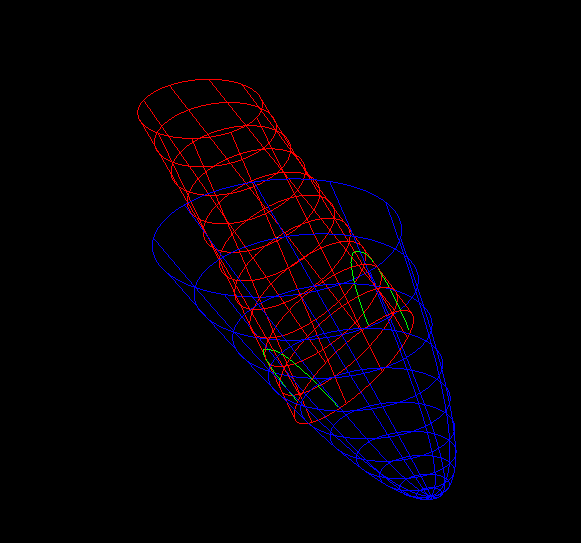Difference between revisions of "User:Phoenix/GSoc2012/Reports"
From BRL-CAD
(→Test Results) |
(→Week 13) |
||
| (78 intermediate revisions by the same user not shown) | |||
| Line 104: | Line 104: | ||
* June 29 | * June 29 | ||
** Tested the results of conversion of superell. (See below) | ** Tested the results of conversion of superell. (See below) | ||
| + | * June 30 | ||
| + | ** Uploaded the raytracing results of superells with e or n > 2. | ||
| + | |||
| + | == Week 7 == | ||
| + | * July 2 | ||
| + | ** Added conversion functions to cline. We first convert cline to an implicit pipe, and then convert the pipe to b-rep. | ||
| + | * July 3 | ||
| + | ** Modified superell_brep.cpp to generate multiple surfaces for superells with e or n > 2. | ||
| + | ** Uploaded images with the modified b-rep conversion routine for superell. | ||
| + | * July 4 | ||
| + | ** Uploaded images of the raytrace results of cline (both implicit and b-rep). | ||
| + | ** Fixed the wrong weight when the center (origin) is set to be control points (superell_brep.cpp). | ||
| + | * July 5 | ||
| + | ** Some minor modifications on brep_debug.cpp, half_brep.cpp and pnts_brep.cpp. | ||
| + | ** Add a b-rep conversion function to grip, but it just returns a NULL ON_Brep pointer because grip is a pseudo solid and doesn't have its own shape. | ||
| + | * July 6 | ||
| + | ** Implemented degree reduction to Bezier curves to simplify the representation of the dsp top surface. But still a long way to go. As I tested it with terra.g, the result made me very upset. There were great differences in the middle of the curves. For dsp with smaller xcnt & ycnt, the result was quite accurate. But it's big xcnt & ycnt that counts, because this is introduced to shorten the raytrace time of dsp with large maps. | ||
| + | ** TODO: Calculate the accumulated deviation. A torelance value TOL might be used to decide whether the result is acceptable or not. Or replace it with a better algorithm. (e.g. The specific way for DSP Cliff mentioned in E-mail) | ||
| + | * July 7 | ||
| + | ** Thought over the specific way to reduce control points on the dsp top surface, but found that finding local minimum and maximum is not quite suitable for Bezier surfaces as this results in non-uniform control points (cannot form a rectangular grid). To keep it uniform may result in even nothing reduced at last. So I'd like to go on with the corrent routines at present. | ||
| + | == Week 8 == | ||
| + | * July 8 | ||
| + | ** Added b-rep conversion function to hf: hf -> dsp -> brep. | ||
| + | * July 9 | ||
| + | ** Added a tolerance variable to control the max error in degree reduction in dsp_brep.cpp. | ||
| + | ** Tested the results of b-rep conversion for dsp. For the 30*30 displacement map, it can be reduced to 16*26 within the tolerance (see the images below), while the 256*256 map in terra.g can only reduced to 254*254 within the tolerance (maybe a bigger tolerance value should be used). | ||
| + | ** Next step for my project: start studying and implementing NURBS surface-surface intersection. [http://brlcad.org/wiki/NURBS_Intersections (http://brlcad.org/wiki/NURBS_Intersections)] Even if I cannot completely finished this project as there is not much time left in this summer, adding some useful "pieces" of it can still be helpful. | ||
| + | * July 10 | ||
| + | ** Read some papers on surface-surface intersection. It's really a HARD project. Two approaches came to mind: | ||
| + | ** 1. Using subdivision methods. The two surfaces can be decomposed into small parts, and the calculation turns to the intersection of these small parts. Two papers Cliff offered seem to use this method (One uses surface triangulation, the other uses small bounding boxes). It might be a rather simple approach, but I'm worried about the performance and accuracy of this method. | ||
| + | ** 2. Using marching algorithms. This approach usually achieve good performance, but lots of math is required. After I went through several papers, I still cannot come up with a complete solution of the first step: Finding starting points using curve-surface intersection. So although this method sounds quite ideal, but the reality is that it's not easy to implement it. | ||
| + | * July 11 | ||
| + | ** No longer used dynamic memory allocations in hf_brep.cpp. | ||
| + | ** Add comment to mark the unused functions in primitives/brep/brep.cpp. | ||
| + | ** Went on studying papers on NURBS surface-surface intersection and read the existing code in brep.cpp as well as opennurbs_ext.cpp(h). Things got much closer, but discussions are still needed before a final solution is formed. | ||
| + | * July 12 | ||
| + | ** In present we decide to focus on the subdivision algorithm which is described in: Adarsh Krishnamurthy, Rahul Khardekar, Sara McMains, Kirk Haller, and Gershon Elber. 2008. Performing efficient NURBS modeling operations on the GPU. In Proceedings of the 2008 ACM symposium on Solid and physical modeling (SPM '08). ACM, New York, NY, USA, 257-268. DOI=10.1145/1364901.1364937 http://doi.acm.org/10.1145/1364901.1364937 | ||
| + | ** Taken the first step of NURBS surface-surface intersection. Surface trees of the two surfaces are generated and intersections of the bounding boxes are calculated. | ||
| + | ** Added the SSI function to opennurbs_ext.h and opennurbs_ext.cpp. | ||
| + | * July 13 | ||
| + | ** Continued working on SSI with subdivision - the second step is to estimate the intersection points with trigonal approximations. Implemented a function to calculate the intersection of two triangles (it sounds simple, but the code is rather long). Finished a draft of the whole second step. But I havn't tested it yet. | ||
| + | ** It seems that m_u and m_v in the bounding box tree do not work. So maybe I should calculate the u domain and v domain beforehand, or modify the SurfaceTree function to update m_u and m_v when building the surface tree. | ||
| + | == Midterm summary == | ||
| + | * The original milestones of my project: | ||
| + | ** '''The remained problems with implemented conversions like ehy, hyp, revolve, sph, ell, tor, extrude, pipe, etc. are fixed. Patches will be updated promptly. (Some have been done now, verification needed.)''' - After several tests on the solids in db/*.g files, they seems to work well now. | ||
| + | ** '''Conversions of non-orgin located primitives are implemented (if they have not been implemented now)''' - Worked on them together with fixing other bugs, completed. | ||
| + | ** '''The missing conversions of implicit primitives are implemented.''' - Most of them are implemented, except metaball, pnts, joint, submodel, constraint, and anno. | ||
| + | ** '''At last a converter working for a whole CSG tree is built (The user interface of my work).''' - The brep command in MGED can convert a comb now (the code is in brep_debug.cpp and libged/brep.c), and conversion.sh can convert the objects in a file. | ||
| + | * About the remaining half of GSoC | ||
| + | ** Work on the NURBS surface-surface intersection project. | ||
| + | == Week 9 == | ||
| + | * July 15 | ||
| + | ** Just did some clean up in opennurbs_ext.cpp - remove unused and shadowed variables to avoid compiler warnings. | ||
| + | * July 16 | ||
| + | ** m_u and m_v is updated in the surfaceBBox() and initialBBox() functions so that they are valid when we calculate the surface sub-patches. | ||
| + | ** Fixed some small bugs in the surface-surface intersection function (copy-paste un-modified). Now that the second step of SSI is finished - points on the curve have been created. | ||
| + | * July 17 | ||
| + | ** Fit the points into NURBS curves using polyline approximation. | ||
| + | ** TODO: (1) Calculate max_dis according to the size of the biggest bounding box. Tests are needed to define a better threshold. (done) (2) Implement a method to test SSI (maybe extend the brep command in MGED with an option "intersect"). (done) | ||
| + | * July 18 | ||
| + | ** Fixed the copy crashing by using pointers to the intersection curves. | ||
| + | ** Added an option to the brep command in MGED to test surface-surface intersection. The syntax is: brep obj1.brep intersect obj2.brep i j . This syntax is used mainly because it's easy to implement. | ||
| + | * July 19 | ||
| + | ** Fixed the bu_malloc(0) failure in surface_surface_intersection(). | ||
| + | ** Uploaded an image of the intersection of a sph and an ehy. | ||
| + | ** TODO: The current intersection routine doesn't work well with plane surfaces, because the bounding box of a plane surface has no volume. (done) | ||
| + | * July 20 | ||
| + | ** Calculated the threshold according to the size of bounding-box. | ||
| + | ** Uploaded an image of the intersection of an epa and a tgc. (Two intersection segments) | ||
| + | * July 21 | ||
| + | ** Modified the brep command so that the max_dis value can be inputted manually within the command for testing. | ||
| + | ** There are still problems with the current intersection: sometimes we get too few points to fit an ideal intersection curve. | ||
| + | |||
| + | == Week 10 == | ||
| + | * July 23 | ||
| + | ** Intersection with a plane surface works well now - for a BBNode with no children within the max depth, copy itself as its child. (An image of related results was uploaded.) | ||
| + | * July 24 | ||
| + | ** There is a trade off between performance and result quality. If we use bigger INTERSECT_MAX_DEPTH (i.e, 10 instead of 8), we get better results but it costs more time. | ||
| + | ** Calculated the coordinates of the intersection points in UV parameter spaces. The next step is to make use of these coordinates to create 2D trimming curves. | ||
| + | * July 25 | ||
| + | ** Do not generate the whole surface tree - only a small useful subset is generated simultaneously with the intersection process. Much faster. | ||
| + | ** TODO: use the tolerance value instead of a constant INTERSECT_MAX_DEPTH. | ||
| + | * July 26 | ||
| + | ** Do not copy the node as its child - just pass it to the next iteration. | ||
| + | ** Fixed the memory leak introduced by this morning's modification. | ||
| + | * July 27 | ||
| + | ** Calculated the intersection curves in UV parameter spaces (trimming curves), and extended the brep command to test them. | ||
| + | |||
| + | == Week 11 == | ||
| + | * July 30 | ||
| + | ** Modified brep_debug.cpp to plot the 2D trimming polyline curves better. Used KnotCount - 1 as the plotres to avoid the interpolation problems. | ||
| + | * July 31 | ||
| + | ** Some minor changes to the b-rep conversion functions in brep_debug.cpp. Free the allocated spaces. | ||
| + | * Aug 1 | ||
| + | ** The first step of manipulating booleans on NURBS b-rep objects. Added a function to /primitives/brep/brep.cpp which is going to deal with the boolean operations of b-reps. | ||
| + | * Aug 2 | ||
| + | ** Added a function in to deal with NURBS curve-curve intersection, which will be useful in evaluating booleans on NURBS. | ||
| + | * Aug 3 | ||
| + | ** Continued work on evaluating booleans on NURBS - generate new trimmed faces with intersection curves (not all situations are considered now, still WIP). | ||
| + | == Week 12 == | ||
| + | * Aug 6 | ||
| + | ** Continued working on dividing trimmed surfaces. It's really quite complicated. Lots of further work and tests are needed. | ||
| + | * Aug 7 | ||
| + | ** The current method for partitioning a trimmed surface is not elegant and convenient. Looked for some materials online and found some valuable resources. | ||
| + | ** Used a new method for partitioning a surface. Followed the algorithms described in: S. Krishnan, A. Narkhede, and D. Manocha. BOOLE: A System to Compute Boolean Combinations of Sculptured Solids. Technical Report TR95-008. Department of Computer Science, University of North Carolina, 1995. Appendix B: Partitioning a Simple Polygon using Non-Intersecting Chains. | ||
| + | * Aug 8 | ||
| + | ** Finished a draft of partitioning a surface. Modifications for special cases and tests are needed. | ||
| + | ** Before starting to write code dealing with inside-outside tests, which is the final step to evaluated NURBS, the current routine of partitioning should be finished beforehand. But it's still a long way to go. I hope I can have good luck with it. | ||
| + | * Aug 9 | ||
| + | ** Added an option to the brep command in MGED to test boolean evaluations (currently only "union"). | ||
| + | ** The evaluation processes are still WIP. The final b-rep structure cannot pass IsValid() at present because edges and vertices are not added. Besides, lots of other modifications are needed. | ||
| + | * Aug 10 | ||
| + | ** Added trims, vertices, edges, etc. to the b-rep structure and checked its validity. | ||
| + | == Week 13 == | ||
| + | * Aug 13 | ||
| + | ** Continued working on adding elements to the ON_Brep structure, trying to make IsValid() succeed. Did some clean up and fixed some bugs, and make the common parts into a separate function. | ||
| + | ** Today is the suggested "pencils down" date. As for the project of evaluating NURBS objects, I think I do not have enough time left to finish it all. At present, faces can be partitioned into several trimmed faces, but some conditions are not considered and problems may still exist. As for the week left, I'd like to go back to the code I wrote all these months, do some clean up, add necessary documents, etc. | ||
| + | * Aug 14 | ||
| + | ** Modified add_elements() and tried using the ON_Surface::Pushup() method first. | ||
| + | ** Some clean up on dsp_brep.cpp: modified comments, renamed a variable with typo, eliminated the debug output, and reduced using dynamic allocated pointers. | ||
| + | ** Added comment before surface_surface_intersection() to describe the algorithm used in SSI. | ||
| + | * Aug 15 | ||
| + | ** Modified cline_brep.cpp, ehy_brep.cpp, epa_brep.cpp, eto_brep.cpp and extrude_brep.cpp and eliminated the memory leak. | ||
| + | * Aug 16 | ||
| + | ** Modified hyp_brep.cpp, part_brep.cpp, pipe_brep.cpp, revolve_brep.cpp, rhc_brep.cpp, rpc_brep.cpp, sketch_brep.cpp and tgc_brep.cpp and eliminated the memory leak. | ||
| + | ** Did some clean up and added comments to /libged/brep.c. | ||
| + | * Aug 17 | ||
| + | ** Add documentation of the brep command in MGED to the wiki page. See: [[http://brlcad.org/wiki/MGED_CMD_brep]] | ||
| + | == Final summary == | ||
| + | * The "Implicit to NURBS conversion" project was mainly done before mid-term evaluation. The milestones and previous goals in the original proposal are finished. | ||
| + | * After mid-term, I focused on the "NURBS Intersection" project, and add many useful features to BRL-CAD, such as calculating surface-surface intersection curves (both in 3d space and 2d UV space), splitting surface and generating new trimmed surfaces, etc. | ||
= Test Results = | = Test Results = | ||
| Line 116: | Line 247: | ||
* havoc.g: havoc (the raytrace of brep+csg takes a too long time, so the result hasn't been generated yet) | * havoc.g: havoc (the raytrace of brep+csg takes a too long time, so the result hasn't been generated yet) | ||
| − | * A DSP primitive with a 30*30 map: ( | + | * A DSP primitive with a 30*30 map: (first: implicit, second: brep, third: reduced to a 16*26 map (sorry for the slightly different views)) |
| − | [[Image:Dsp implicit.png]] [[Image:Dsp brep.png]] | + | [[Image:Dsp implicit.png]] [[Image:Dsp brep.png]] [[Image:Dsp reduced.png]] |
* Brep form of superell primitives with axes of the same magnitude: (left: n = 0.8, e = 0.2, right: n = 1.0, e = 2.0) | * Brep form of superell primitives with axes of the same magnitude: (left: n = 0.8, e = 0.2, right: n = 1.0, e = 2.0) | ||
** Reference page: http://paulbourke.net/geometry/superellipse/ | ** Reference page: http://paulbourke.net/geometry/superellipse/ | ||
[[Image:Superell 0.8 0.2.png]] [[Image:Superell 1.0 2.0.png]] | [[Image:Superell 0.8 0.2.png]] [[Image:Superell 1.0 2.0.png]] | ||
| + | ** There is still some problems when n > 2 or e > 2. (left: n = 0.2, e = 3.0, right: n = e = 3.0) | ||
| + | [[Image:Superell 0.2 3.0.png]] [[Image:Superell 3.0 3.0.png]] | ||
| + | ** The problem above was fixed in r51405. (first: n = 0.2, e = 3.0, second: n = e = 3.0, third: n = 3.0, e = 0.2) | ||
| + | [[Image:Superell 0.2 3.0 fixed.png]] [[Image:Superell 3.0 3.0 fixed.png]] [[Image:Superell 3.0 0.2 fixed.png]] | ||
| + | |||
| + | * A cline primitive raytraced in different views. You can see that it's a primitive whose raytrace is view-dependent. We use a pipe to represent it when it's converted to b-rep, whose raytrace is view-independent. The shape of the pipe is according to what we see when plotting a cline with the draw command in MGED. (Two different views, left: implicit, right: brep) | ||
| + | [[Image:Cline implicit 1.png]] [[Image:Cline brep 1.png]] | ||
| + | [[Image:Cline implicit 2.png]] [[Image:Cline brep 2.png]] | ||
| + | |||
| + | * The intersection curve (green) of a sph (red) and an ehy (blue). | ||
| + | [[Image:Sph ehy.png]] | ||
| + | * The intersection curves (green) of a tgc (red) and an epa (blue). (Two segments) | ||
| + | [[Image:Tgc epa.png]] | ||
| + | * The intersection curve (green) of a plane surface (red) and an ehy (blue). | ||
| + | [[Image:Planar ehy.png]] | ||
= Original development timeline = | = Original development timeline = | ||
Latest revision as of 05:33, 22 August 2012
Contents
Log[edit]
Community Bonding[edit]
- May 2
- Downloaded the source code of the latest revision from svn checkout and got more familiar with subversion.
- Compiled and built the source both in Ubuntu and Windows (Visual Studio 2010) successfully.
- May 13
- Found and fixed a small bug in eto_brep (the rotation axis of eto is wrong), and submitted a patch on sourceforge.net.
- May 15
- Modified the eto_brep patch with the test case provided by Cliff.
- May 16
- Continued working on the conversion of eto.
- Tested the brep conversion of hyp, but found the raytrace result of implicit CSG hyp quite strange.
- May 17
- The raytrace of implicit hyp is wrong when H is not perpendicular to A.
- Fixed the conversion to brep of hyp (havn't commited yet).
- May 18
- My first SVN Commit: fixed the shearing direction of hyp.
Week 1[edit]
- May 21
- Fixed the bug of wrong id & od for pipe b-rep, by changing some prevp to curp.
- Dealt with duplicated points by deleting them from the linklist.
- May 22
- Added some control to deal with special cases in pipe_brep.cpp and add a few comments.
- May 23
- Read and tried to understood the code in revolve_brep.cpp, but got confused by the implicit definition.
- Changed the revolution axis and origin of the sketch plane of revolve_brep.
- May 24
- Changed the position of the sketch in extrude_brep according to the parameters.
- Fixed the plane direction of circle arcs in sketch_brep as well as in revolve_brep.
- May 25
- Dealt with non-full revolution of revolve_brep. It took a long time to get the expected result, but I got more familiar to NURBS/BREP during that procedure.
Week 2[edit]
- May 27
- Tested and examined the implemented brep conversions. Checked the current status of my work.
- May 28
- Added the implicit -> brep conversion to conversion.sh, so that massive testing will be more convenient.
- May 29
- Tested the functionality of conversion.sh and brep conversions. Made a small change.
- Modified brep.c in libged to check whether the conversion is successful.
- May 30
- Read the code in clone.c, and began to implement the temporary unevaluated conversion of comb in the brep command in MGED.
- May 31
- Extended the functionality of the brep command in MGED to deal with comb. Unevaluated breps are generated. More tests are needed.
- June 1
- The unevaluated conversion for comb has been implemented. Changed conversion.sh accordingly. And the whole elasped time for each object is evaluated.
- Handled some exceptions in brep_debug.cpp.
- Freed memories and corrected the "name existed" output in brep.c in libged.
- June 2
- Tested the brep conversion on ktank.g, m35.g, etc. with conversion.sh.
- Modified brep_debug.cpp to deal with empty combs.
Week 3[edit]
- June 3
- Fixed the wrong malloc size and freed tmpname before returning in brep_debug.cpp.
- June 4
- Modified openNUBRS_ext.cpp to quell set-but-unused warnings.
- Tested brep conversion of all /db/*.g files. Looked into the log to find out what to do next.
- Found a bug in pipe_brep.cpp dealing with colinear points.
- June 5
- Modified pipe_brep.cpp. It's much better now, but problems still remain.
- June 6
- Fixed a concealed bug in pipe_brep.cpp. Now it works properly.
- June 7
- Fixed the destruction failure in pipe_brep.cpp by duplicating the curves.
- June 8
- Modified brep_debug.cpp to skip the conversion of half when converting a comb. The implicit primitive of half remains in the hierarchy.
- Explored the usage of ON_BrepRegion to represent an infinite halfspace, but had no good luck.
Week 4[edit]
- June 11 - June 18
- Final examination week in our school.
Week 5[edit]
- June 18
- Final exams finished. Started to work!
- Added pnts to the ignore list when converting a comb.
- Modified the describe and ifree functions in pnts.c checking whether count==0 to avoid segmentation fault.
- June 19
- Corrected the wrong comments in arb8_brep.cpp and arbn_brep.cpp.
- Add a brep conversion function to ars, which first converts it to an nmg and then to b-rep.
- June 20
- Use ft_brep functions for half and pnts, returning a NULL brep pointer, and check within brep_conversion() and brep_conversion_tree().
- June 21
- Tried implementing rt_part_brep() for primitive part. Things get much closer now after much tests and modifications.
- June 22
- Finished a raw version of brep conversion for part. Some special cases need to be considered later.
- June 23
- Enhanced some special cases (sphere) in part_brep.cpp.
Week 6[edit]
- June 24
- Fixed the wrong normal direction of the brep form of part.
- June 25
- Studied the primitive metaball. Found it quite hard to get started.
- June 26
- Studied the two papers Cliff provided on metaballs, but still cannot find the answer.
- Copied the transformation matrix when converting the leaves in a tree. (Later adjusted to copying all data from the old tree first)
- June 27
- Evaluated the results and uploaded the screenshots to the log page. (See "Test Results")
- Modified dsp_brep.cpp, using the dsp_stom matrix to do the transformation, instead of using the magic numbers.
- June 28
- Implemented a b-rep conversion function for superell.
- June 29
- Tested the results of conversion of superell. (See below)
- June 30
- Uploaded the raytracing results of superells with e or n > 2.
Week 7[edit]
- July 2
- Added conversion functions to cline. We first convert cline to an implicit pipe, and then convert the pipe to b-rep.
- July 3
- Modified superell_brep.cpp to generate multiple surfaces for superells with e or n > 2.
- Uploaded images with the modified b-rep conversion routine for superell.
- July 4
- Uploaded images of the raytrace results of cline (both implicit and b-rep).
- Fixed the wrong weight when the center (origin) is set to be control points (superell_brep.cpp).
- July 5
- Some minor modifications on brep_debug.cpp, half_brep.cpp and pnts_brep.cpp.
- Add a b-rep conversion function to grip, but it just returns a NULL ON_Brep pointer because grip is a pseudo solid and doesn't have its own shape.
- July 6
- Implemented degree reduction to Bezier curves to simplify the representation of the dsp top surface. But still a long way to go. As I tested it with terra.g, the result made me very upset. There were great differences in the middle of the curves. For dsp with smaller xcnt & ycnt, the result was quite accurate. But it's big xcnt & ycnt that counts, because this is introduced to shorten the raytrace time of dsp with large maps.
- TODO: Calculate the accumulated deviation. A torelance value TOL might be used to decide whether the result is acceptable or not. Or replace it with a better algorithm. (e.g. The specific way for DSP Cliff mentioned in E-mail)
- July 7
- Thought over the specific way to reduce control points on the dsp top surface, but found that finding local minimum and maximum is not quite suitable for Bezier surfaces as this results in non-uniform control points (cannot form a rectangular grid). To keep it uniform may result in even nothing reduced at last. So I'd like to go on with the corrent routines at present.
Week 8[edit]
- July 8
- Added b-rep conversion function to hf: hf -> dsp -> brep.
- July 9
- Added a tolerance variable to control the max error in degree reduction in dsp_brep.cpp.
- Tested the results of b-rep conversion for dsp. For the 30*30 displacement map, it can be reduced to 16*26 within the tolerance (see the images below), while the 256*256 map in terra.g can only reduced to 254*254 within the tolerance (maybe a bigger tolerance value should be used).
- Next step for my project: start studying and implementing NURBS surface-surface intersection. (http://brlcad.org/wiki/NURBS_Intersections) Even if I cannot completely finished this project as there is not much time left in this summer, adding some useful "pieces" of it can still be helpful.
- July 10
- Read some papers on surface-surface intersection. It's really a HARD project. Two approaches came to mind:
- 1. Using subdivision methods. The two surfaces can be decomposed into small parts, and the calculation turns to the intersection of these small parts. Two papers Cliff offered seem to use this method (One uses surface triangulation, the other uses small bounding boxes). It might be a rather simple approach, but I'm worried about the performance and accuracy of this method.
- 2. Using marching algorithms. This approach usually achieve good performance, but lots of math is required. After I went through several papers, I still cannot come up with a complete solution of the first step: Finding starting points using curve-surface intersection. So although this method sounds quite ideal, but the reality is that it's not easy to implement it.
- July 11
- No longer used dynamic memory allocations in hf_brep.cpp.
- Add comment to mark the unused functions in primitives/brep/brep.cpp.
- Went on studying papers on NURBS surface-surface intersection and read the existing code in brep.cpp as well as opennurbs_ext.cpp(h). Things got much closer, but discussions are still needed before a final solution is formed.
- July 12
- In present we decide to focus on the subdivision algorithm which is described in: Adarsh Krishnamurthy, Rahul Khardekar, Sara McMains, Kirk Haller, and Gershon Elber. 2008. Performing efficient NURBS modeling operations on the GPU. In Proceedings of the 2008 ACM symposium on Solid and physical modeling (SPM '08). ACM, New York, NY, USA, 257-268. DOI=10.1145/1364901.1364937 http://doi.acm.org/10.1145/1364901.1364937
- Taken the first step of NURBS surface-surface intersection. Surface trees of the two surfaces are generated and intersections of the bounding boxes are calculated.
- Added the SSI function to opennurbs_ext.h and opennurbs_ext.cpp.
- July 13
- Continued working on SSI with subdivision - the second step is to estimate the intersection points with trigonal approximations. Implemented a function to calculate the intersection of two triangles (it sounds simple, but the code is rather long). Finished a draft of the whole second step. But I havn't tested it yet.
- It seems that m_u and m_v in the bounding box tree do not work. So maybe I should calculate the u domain and v domain beforehand, or modify the SurfaceTree function to update m_u and m_v when building the surface tree.
Midterm summary[edit]
- The original milestones of my project:
- The remained problems with implemented conversions like ehy, hyp, revolve, sph, ell, tor, extrude, pipe, etc. are fixed. Patches will be updated promptly. (Some have been done now, verification needed.) - After several tests on the solids in db/*.g files, they seems to work well now.
- Conversions of non-orgin located primitives are implemented (if they have not been implemented now) - Worked on them together with fixing other bugs, completed.
- The missing conversions of implicit primitives are implemented. - Most of them are implemented, except metaball, pnts, joint, submodel, constraint, and anno.
- At last a converter working for a whole CSG tree is built (The user interface of my work). - The brep command in MGED can convert a comb now (the code is in brep_debug.cpp and libged/brep.c), and conversion.sh can convert the objects in a file.
- About the remaining half of GSoC
- Work on the NURBS surface-surface intersection project.
Week 9[edit]
- July 15
- Just did some clean up in opennurbs_ext.cpp - remove unused and shadowed variables to avoid compiler warnings.
- July 16
- m_u and m_v is updated in the surfaceBBox() and initialBBox() functions so that they are valid when we calculate the surface sub-patches.
- Fixed some small bugs in the surface-surface intersection function (copy-paste un-modified). Now that the second step of SSI is finished - points on the curve have been created.
- July 17
- Fit the points into NURBS curves using polyline approximation.
- TODO: (1) Calculate max_dis according to the size of the biggest bounding box. Tests are needed to define a better threshold. (done) (2) Implement a method to test SSI (maybe extend the brep command in MGED with an option "intersect"). (done)
- July 18
- Fixed the copy crashing by using pointers to the intersection curves.
- Added an option to the brep command in MGED to test surface-surface intersection. The syntax is: brep obj1.brep intersect obj2.brep i j . This syntax is used mainly because it's easy to implement.
- July 19
- Fixed the bu_malloc(0) failure in surface_surface_intersection().
- Uploaded an image of the intersection of a sph and an ehy.
- TODO: The current intersection routine doesn't work well with plane surfaces, because the bounding box of a plane surface has no volume. (done)
- July 20
- Calculated the threshold according to the size of bounding-box.
- Uploaded an image of the intersection of an epa and a tgc. (Two intersection segments)
- July 21
- Modified the brep command so that the max_dis value can be inputted manually within the command for testing.
- There are still problems with the current intersection: sometimes we get too few points to fit an ideal intersection curve.
Week 10[edit]
- July 23
- Intersection with a plane surface works well now - for a BBNode with no children within the max depth, copy itself as its child. (An image of related results was uploaded.)
- July 24
- There is a trade off between performance and result quality. If we use bigger INTERSECT_MAX_DEPTH (i.e, 10 instead of 8), we get better results but it costs more time.
- Calculated the coordinates of the intersection points in UV parameter spaces. The next step is to make use of these coordinates to create 2D trimming curves.
- July 25
- Do not generate the whole surface tree - only a small useful subset is generated simultaneously with the intersection process. Much faster.
- TODO: use the tolerance value instead of a constant INTERSECT_MAX_DEPTH.
- July 26
- Do not copy the node as its child - just pass it to the next iteration.
- Fixed the memory leak introduced by this morning's modification.
- July 27
- Calculated the intersection curves in UV parameter spaces (trimming curves), and extended the brep command to test them.
Week 11[edit]
- July 30
- Modified brep_debug.cpp to plot the 2D trimming polyline curves better. Used KnotCount - 1 as the plotres to avoid the interpolation problems.
- July 31
- Some minor changes to the b-rep conversion functions in brep_debug.cpp. Free the allocated spaces.
- Aug 1
- The first step of manipulating booleans on NURBS b-rep objects. Added a function to /primitives/brep/brep.cpp which is going to deal with the boolean operations of b-reps.
- Aug 2
- Added a function in to deal with NURBS curve-curve intersection, which will be useful in evaluating booleans on NURBS.
- Aug 3
- Continued work on evaluating booleans on NURBS - generate new trimmed faces with intersection curves (not all situations are considered now, still WIP).
Week 12[edit]
- Aug 6
- Continued working on dividing trimmed surfaces. It's really quite complicated. Lots of further work and tests are needed.
- Aug 7
- The current method for partitioning a trimmed surface is not elegant and convenient. Looked for some materials online and found some valuable resources.
- Used a new method for partitioning a surface. Followed the algorithms described in: S. Krishnan, A. Narkhede, and D. Manocha. BOOLE: A System to Compute Boolean Combinations of Sculptured Solids. Technical Report TR95-008. Department of Computer Science, University of North Carolina, 1995. Appendix B: Partitioning a Simple Polygon using Non-Intersecting Chains.
- Aug 8
- Finished a draft of partitioning a surface. Modifications for special cases and tests are needed.
- Before starting to write code dealing with inside-outside tests, which is the final step to evaluated NURBS, the current routine of partitioning should be finished beforehand. But it's still a long way to go. I hope I can have good luck with it.
- Aug 9
- Added an option to the brep command in MGED to test boolean evaluations (currently only "union").
- The evaluation processes are still WIP. The final b-rep structure cannot pass IsValid() at present because edges and vertices are not added. Besides, lots of other modifications are needed.
- Aug 10
- Added trims, vertices, edges, etc. to the b-rep structure and checked its validity.
Week 13[edit]
- Aug 13
- Continued working on adding elements to the ON_Brep structure, trying to make IsValid() succeed. Did some clean up and fixed some bugs, and make the common parts into a separate function.
- Today is the suggested "pencils down" date. As for the project of evaluating NURBS objects, I think I do not have enough time left to finish it all. At present, faces can be partitioned into several trimmed faces, but some conditions are not considered and problems may still exist. As for the week left, I'd like to go back to the code I wrote all these months, do some clean up, add necessary documents, etc.
- Aug 14
- Modified add_elements() and tried using the ON_Surface::Pushup() method first.
- Some clean up on dsp_brep.cpp: modified comments, renamed a variable with typo, eliminated the debug output, and reduced using dynamic allocated pointers.
- Added comment before surface_surface_intersection() to describe the algorithm used in SSI.
- Aug 15
- Modified cline_brep.cpp, ehy_brep.cpp, epa_brep.cpp, eto_brep.cpp and extrude_brep.cpp and eliminated the memory leak.
- Aug 16
- Modified hyp_brep.cpp, part_brep.cpp, pipe_brep.cpp, revolve_brep.cpp, rhc_brep.cpp, rpc_brep.cpp, sketch_brep.cpp and tgc_brep.cpp and eliminated the memory leak.
- Did some clean up and added comments to /libged/brep.c.
- Aug 17
- Add documentation of the brep command in MGED to the wiki page. See: [[1]]
Final summary[edit]
- The "Implicit to NURBS conversion" project was mainly done before mid-term evaluation. The milestones and previous goals in the original proposal are finished.
- After mid-term, I focused on the "NURBS Intersection" project, and add many useful features to BRL-CAD, such as calculating surface-surface intersection curves (both in 3d space and 2d UV space), splitting surface and generating new trimmed surfaces, etc.
Test Results[edit]
The brep conversion has been tested on several db/*.g files. Below are the screenshots of the raytrace results.
- m35.g: component (left: implicit + csg, right: brep + csg)
- ktank.g: tank (left: implicit + csg, right: brep + csg)
- havoc.g: havoc (the raytrace of brep+csg takes a too long time, so the result hasn't been generated yet)
- A DSP primitive with a 30*30 map: (first: implicit, second: brep, third: reduced to a 16*26 map (sorry for the slightly different views))
- Brep form of superell primitives with axes of the same magnitude: (left: n = 0.8, e = 0.2, right: n = 1.0, e = 2.0)
- Reference page: http://paulbourke.net/geometry/superellipse/
- There is still some problems when n > 2 or e > 2. (left: n = 0.2, e = 3.0, right: n = e = 3.0)
- The problem above was fixed in r51405. (first: n = 0.2, e = 3.0, second: n = e = 3.0, third: n = 3.0, e = 0.2)
- A cline primitive raytraced in different views. You can see that it's a primitive whose raytrace is view-dependent. We use a pipe to represent it when it's converted to b-rep, whose raytrace is view-independent. The shape of the pipe is according to what we see when plotting a cline with the draw command in MGED. (Two different views, left: implicit, right: brep)
- The intersection curve (green) of a sph (red) and an ehy (blue).
- The intersection curves (green) of a tgc (red) and an epa (blue). (Two segments)
- The intersection curve (green) of a plane surface (red) and an ehy (blue).
Original development timeline[edit]
- - May 21 (~4 weeks)
- Study materials on NURBS/BREP etc
- Read the codes in librt/primitives
- Get familiar to OpenNURBS
- Fix some bugs and make patches
- Implement a method for convenient testing (finished)
- May 21 - June 10 (~3 weeks)
- Modify implemented conversions if not finished
- pipe
- sph, ell, tor, hyp
- eto, extrude, revolve, etc.
- Modify implemented conversions if not finished
- June 11 - June 18 (~1 week)
- Final examination week in our school
- June 19 - July 1 (~2 weeks)
- Still work on existing conversions
- Work on non-origin primitives
- Deduce transformation matrices
- Apply the transformation
- Test the results and write documents
- July 1 - July 29 (~4 weeks)
- Add new conversions to missing primitives
- Test whether it works well
- Write clear documents
- From easy ones to hard ones
- July 1 - July 8 (1 week)
- rec
- ars
- half
- ell1
- July 8 - July 15 (1 week)
- metaball
- pnts
- part
- grip
- July 15 - July 22 (1 week)
- superell
- cline
- July 22 - July 29 (1 week)
- hf
- other missing primitives
- Add new conversions to missing primitives
- July 29 - August 13 (~2 week)
- Write a convert for whole
- Write a function to walk the tree
- Add a command to MGED
- Discussions and documents
- Test the work and fix bugs
- Write a convert for whole
- August 13 - August 20 (~1 week)
- Pencil down data
- Improve documentation
- Evaluations
- Pencil down data
- Post-GSoc
- Further involvement with BRL-CAD :)
